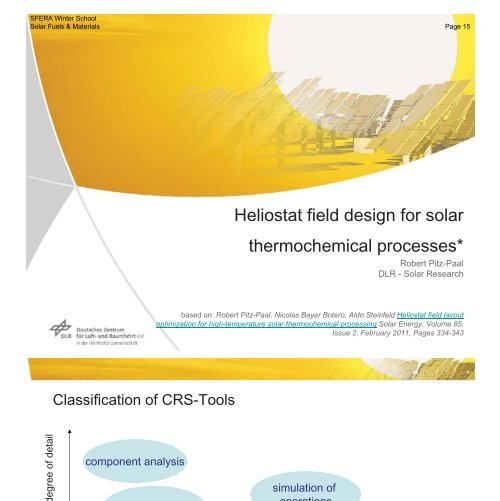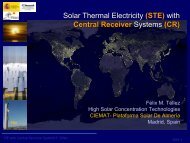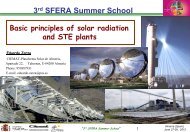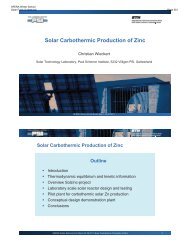Heliostat field design for solar thermochemical processes* - SFERA
Heliostat field design for solar thermochemical processes* - SFERA
Heliostat field design for solar thermochemical processes* - SFERA
Create successful ePaper yourself
Turn your PDF publications into a flip-book with our unique Google optimized e-Paper software.
<strong>SFERA</strong> Winter School<br />
Solar Fuels & Materials Page 15<br />
<strong>Heliostat</strong> <strong>field</strong> <strong>design</strong> <strong>for</strong> <strong>solar</strong><br />
<strong>thermochemical</strong> <strong>processes*</strong><br />
Robert Pitz-Paal<br />
DLR - Solar Research<br />
based on: Robert Pitz-Paal, Nicolas Bayer Botero, Aldo Steinfeld <strong>Heliostat</strong> <strong>field</strong> layout<br />
optimization <strong>for</strong> high-temperature <strong>solar</strong> <strong>thermochemical</strong> processing Solar Energy, Volume 85,<br />
Issue 2, February 2011, Pages 334-343<br />
Classification of CRS-Tools<br />
degree of detail<br />
component analysis<br />
system analysis<br />
system layout<br />
simulation of<br />
operations<br />
optimisation of<br />
operations<br />
per<strong>for</strong>mance calc.<br />
layout optimisation<br />
calculation speed<br />
2
<strong>SFERA</strong> Winter School<br />
Solar Fuels & Materials Page 16<br />
Maximizing annual energy<br />
output<br />
or<br />
Minimizing production cost<br />
<strong>Heliostat</strong> Field Optimization<br />
by variation of<br />
Design parameters<br />
heliostat position<br />
tower height<br />
receiver aperture<br />
…<br />
Operation parameters<br />
operation temperature<br />
…<br />
E<br />
S<br />
W<br />
N<br />
3<br />
Per<strong>for</strong>mance Calculation<br />
Given: <strong>Heliostat</strong>, <strong>Heliostat</strong> Positions, Aim Points, Tower, Receiver, (Secondary)<br />
Task: calculate annual per<strong>for</strong>mance<br />
P<br />
inc<br />
( x,<br />
y,<br />
t)<br />
DNI ( t)<br />
FMir<br />
refl<br />
atmo<br />
( x,<br />
y)<br />
cos(<br />
x,<br />
y,<br />
t)<br />
b&<br />
• coordinate systems:<br />
s<br />
( x,<br />
y,<br />
t)<br />
<br />
inc<br />
( x,<br />
y,<br />
t)<br />
• tower coordinate system<br />
• sun angles<br />
• azimuth 0° = south<br />
• elevation 90° = zenith<br />
y<br />
x<br />
• receiver coordinate systems<br />
4
<strong>SFERA</strong> Winter School<br />
Solar Fuels & Materials Page 17<br />
Per<strong>for</strong>mance Calculation<br />
Given: <strong>Heliostat</strong>, <strong>Heliostat</strong> Positions, Aim Points, Tower, Receiver, (Secondary)<br />
Task: calculate annual per<strong>for</strong>mance<br />
90<br />
80<br />
70<br />
60<br />
50<br />
P<br />
inc<br />
( x,<br />
y,<br />
t)<br />
DNI ( t)<br />
FMir<br />
refl<br />
atmo<br />
( x,<br />
y)<br />
cos(<br />
x,<br />
y,<br />
t)<br />
b&<br />
• time system:<br />
9 h<br />
Vormittag<br />
10 h<br />
11 h<br />
Mittag<br />
12 h<br />
Jun<br />
Mai/Jul<br />
Apr/Aug<br />
Mär/Sep<br />
s<br />
( x,<br />
y,<br />
t)<br />
<br />
13 h<br />
inc<br />
Nachmittag<br />
14 h<br />
( x,<br />
y,<br />
t)<br />
15 h<br />
40<br />
30<br />
20<br />
6 h<br />
7 h<br />
8 h<br />
9 h<br />
10 h<br />
11 h<br />
10<br />
8 h<br />
16 h<br />
5 h<br />
0<br />
60 90 120 150 180 210 240 270<br />
Feb/Okt<br />
Jan/Nov<br />
Dez<br />
13 h<br />
14 h<br />
15 h<br />
16 h<br />
17 h<br />
18 h<br />
5<br />
Per<strong>for</strong>mance Calculation<br />
Given: <strong>Heliostat</strong>, <strong>Heliostat</strong> Positions, Aim Points, Tower, Receiver, (Secondary)<br />
Task: calculate annual per<strong>for</strong>mance<br />
P<br />
inc<br />
( x,<br />
y,<br />
t)<br />
DNI ( t)<br />
FMir<br />
refl<br />
atmo<br />
( x,<br />
y)<br />
cos(<br />
x,<br />
y,<br />
t)<br />
b&<br />
• time system:<br />
( x,<br />
y,<br />
t)<br />
<br />
( x,<br />
y,<br />
t)<br />
• 7 months: Dec, Jan/Nov, Feb/Oct, Mar/Sep, Apr/Aug, Mai/Jul, Jun<br />
• days/month: 31 61 59 61 61 62 60<br />
• one representative day per month (21st)<br />
• local <strong>solar</strong> time, hourly intervals<br />
s<br />
inc<br />
6
<strong>SFERA</strong> Winter School<br />
Solar Fuels & Materials Page 18<br />
Per<strong>for</strong>mance Calculation<br />
Given: <strong>Heliostat</strong>, <strong>Heliostat</strong> Positions, Aim Points, Tower, Receiver, (Secondary)<br />
Task: calculate annual per<strong>for</strong>mance<br />
P<br />
inc<br />
( x,<br />
y,<br />
t)<br />
DNI ( t)<br />
FMir<br />
refl<br />
atmo<br />
( x,<br />
y)<br />
cos(<br />
x,<br />
y,<br />
t)<br />
b&<br />
• radiation model:<br />
• tabulated data<br />
• clear sky model from Hottel (1976):<br />
s<br />
( x,<br />
y,<br />
t)<br />
<br />
inc<br />
( x,<br />
y,<br />
t)<br />
DNI ( t)<br />
( LAT , h,<br />
day,<br />
time)<br />
<br />
atmo<br />
IRR ET<br />
850<br />
LAT 35°N, 0m, <strong>solar</strong> noon<br />
800<br />
DNI [W/m²]<br />
750<br />
700<br />
650<br />
600<br />
1 2 3 4 5 6 7 8 9 10 11 12<br />
7<br />
Per<strong>for</strong>mance Calculation<br />
Given: <strong>Heliostat</strong>, <strong>Heliostat</strong> Positions, Aim Points, Tower, Receiver, (Secondary)<br />
Task: calculate annual per<strong>for</strong>mance<br />
P<br />
inc<br />
( x,<br />
y,<br />
t)<br />
DNI ( t)<br />
FMir<br />
refl<br />
atmo<br />
( x,<br />
y)<br />
cos(<br />
x,<br />
y,<br />
t)<br />
b&<br />
• atmospheric attenuation:<br />
atmo<br />
( x,<br />
y)<br />
f ( slant range)<br />
1.00<br />
s<br />
( x,<br />
y,<br />
t)<br />
<br />
inc<br />
( x,<br />
y,<br />
t)<br />
• agrees well with Pittman/Vant-Hull at<br />
Rho_H2O 7 g/m³<br />
Vis<br />
40 km<br />
H<br />
0 km<br />
h_tower 0.1 km<br />
Transmissivity [-]<br />
0.95<br />
0.90<br />
0.85<br />
0.80<br />
0.75<br />
0.70<br />
0.65<br />
Pitman/Vant-Hull<br />
HFLCAL<br />
0.60<br />
0 0.5 1 1.5 2 2.5 3<br />
Slant Range [km]<br />
8
<strong>SFERA</strong> Winter School<br />
Solar Fuels & Materials Page 19<br />
Per<strong>for</strong>mance Calculation<br />
Given: <strong>Heliostat</strong>, <strong>Heliostat</strong> Positions, Aim Points, Tower, Receiver, (Secondary)<br />
Task: calculate annual per<strong>for</strong>mance<br />
P<br />
inc<br />
( x,<br />
y,<br />
t)<br />
DNI ( t)<br />
FMir<br />
refl<br />
atmo<br />
( x,<br />
y)<br />
cos(<br />
x,<br />
y,<br />
t)<br />
b&<br />
• cosine factor<br />
s<br />
( x,<br />
y,<br />
t)<br />
<br />
inc<br />
( x,<br />
y,<br />
t)<br />
9<br />
Per<strong>for</strong>mance Calculation<br />
Given: <strong>Heliostat</strong>, <strong>Heliostat</strong> Positions, Aim Points, Tower, Receiver, (Secondary)<br />
Task: calculate annual per<strong>for</strong>mance<br />
P<br />
inc<br />
( x,<br />
y,<br />
t)<br />
DNI ( t)<br />
FMir<br />
refl<br />
atmo<br />
( x,<br />
y)<br />
cos(<br />
x,<br />
y,<br />
t)<br />
b&<br />
• shading<br />
s<br />
( x,<br />
y,<br />
t)<br />
<br />
inc<br />
( x,<br />
y,<br />
t)<br />
10
<strong>SFERA</strong> Winter School<br />
Solar Fuels & Materials Page 20<br />
Per<strong>for</strong>mance Calculation<br />
Given: <strong>Heliostat</strong>, <strong>Heliostat</strong> Positions, Aim Points, Tower, Receiver, (Secondary)<br />
Task: calculate annual per<strong>for</strong>mance<br />
P<br />
inc<br />
( x,<br />
y,<br />
t)<br />
DNI ( t)<br />
FMir<br />
refl<br />
atmo<br />
( x,<br />
y)<br />
cos(<br />
x,<br />
y,<br />
t)<br />
b&<br />
• blocking<br />
s<br />
( x,<br />
y,<br />
t)<br />
<br />
inc<br />
( x,<br />
y,<br />
t)<br />
11<br />
Background<br />
Design and optimization of <strong>solar</strong> tower systems require the<br />
calculation of the reflected beam in the target plane<br />
12
<strong>SFERA</strong> Winter School<br />
Solar Fuels & Materials Page 21<br />
Background<br />
Design and optimization of <strong>solar</strong> tower systems require the<br />
calculation of the reflected beam in the target plane<br />
Deviations from ideal<br />
concentration:<br />
• non-parallel rays<br />
• alignment error<br />
• shape error<br />
• slope error<br />
• diffuse reflection<br />
• (off-axis-reflection)<br />
13<br />
Background<br />
statistical approach (ray-tracing)<br />
analytical approach (convolution)<br />
<br />
<br />
<br />
I M E S<br />
I( x,<br />
y)<br />
M ( x1 , y1)<br />
E(<br />
x2<br />
x1,<br />
y2<br />
y1)<br />
S(<br />
x x2,<br />
y y2)<br />
dx1dy1dx2dy2<br />
e<br />
I(<br />
x,<br />
y)<br />
<br />
2 2<br />
(<br />
x y )<br />
2<br />
/ 2<br />
<br />
<br />
i0 j0<br />
Cij<br />
Hi(<br />
x)<br />
H<br />
j<br />
( y)<br />
i!<br />
j!<br />
14
<strong>SFERA</strong> Winter School<br />
Solar Fuels & Materials Page 22<br />
HFLCAL Approach<br />
HFLCAL uses a simplified convolution approach:<br />
The reflected image of each heliostat is approximated by a circular normal<br />
distribution (“Gaussian”)<br />
F<br />
r ²<br />
1 <br />
2<br />
²<br />
( )<br />
r<br />
e<br />
2<br />
²<br />
<br />
2<br />
beam error<br />
<br />
2<br />
sun<br />
<br />
2<br />
beam quality<br />
0.035<br />
0.3<br />
0.030<br />
0.25<br />
0.025<br />
"Kuiper"<br />
probability [-]<br />
0.020<br />
0.015<br />
"Gaussian"<br />
0.2<br />
0.15<br />
0.010<br />
0.1<br />
0.005<br />
0.05<br />
0.000<br />
0 0.5 1 1.5 2 2.5 3 3.5 4 4.5 5 5.5 6 6.5 7<br />
r [mrad]<br />
sun<br />
0<br />
-5 -4 -3 -2 -1 0 1 2 3 4 5<br />
2<br />
mirror<br />
15<br />
Accuracy of Mathematical Model<br />
F<br />
r ²<br />
1 <br />
2<br />
²<br />
( )<br />
r<br />
e<br />
2<br />
²<br />
<br />
2<br />
beam error<br />
<br />
2<br />
sun<br />
<br />
2<br />
beam quality<br />
• Pettit, Vittitoe and Biggs (1983) found good agreement when beam error<br />
2 sun<br />
• Central Limit Theorem: „superposition of a great number of any distributions<br />
converges towards a normal distribution“<br />
200<br />
200<br />
180<br />
160<br />
ray-tracing<br />
HFLCAL<br />
180<br />
160<br />
ray-tracing<br />
HFLCAL<br />
140<br />
140<br />
120<br />
120<br />
100<br />
100<br />
80<br />
80<br />
60<br />
60<br />
40<br />
40<br />
20<br />
20<br />
0<br />
-2.5 -2 -1.5 -1 -0.5 0 0.5 1 1.5 2 2.5<br />
perfect mirror<br />
0<br />
-2.5 -2 -1.5 -1 -0.5 0 0.5 1 1.5 2 2.5<br />
realistic mirror<br />
16
<strong>SFERA</strong> Winter School<br />
Solar Fuels & Materials Page 23<br />
Accuracy of Mathematical Model<br />
F<br />
r ²<br />
1 <br />
2<br />
²<br />
( )<br />
r<br />
e<br />
2<br />
²<br />
<br />
2<br />
beam error<br />
<br />
2<br />
sun<br />
<br />
2<br />
beam quality<br />
How to chose the correct value <strong>for</strong> beam error<br />
<br />
10<br />
4.5%<br />
9<br />
4.0%<br />
8<br />
3.5%<br />
total sigma [mrad]<br />
7<br />
6<br />
5<br />
4<br />
3<br />
2<br />
RMS (HFLCAL-RayTracing)<br />
3.0%<br />
2.5%<br />
2.0%<br />
1.5%<br />
1.0%<br />
1<br />
0.5%<br />
0<br />
0 0.5 1 1.5 2 2.5 3 3.5 4 4.5 5<br />
slope error (normal) [mrad]<br />
0.0%<br />
0 0.5 1 1.5 2 2.5 3 3.5 4 4.5<br />
slope error (normal) [mrad]<br />
total sigma<br />
error<br />
17<br />
Accuracy of Mathematical Model<br />
tracking errors influence the amount of intercepted energy<br />
<br />
2<br />
beam error<br />
<br />
2<br />
sun<br />
<br />
2<br />
beam quality<br />
( 2<br />
track<br />
)<br />
2<br />
<br />
track<br />
<br />
<br />
<br />
axis1 axis2<br />
18
<strong>SFERA</strong> Winter School<br />
Solar Fuels & Materials Page 24<br />
Accuracy of Mathematical Model<br />
astigmatism influences the size and shape of the reflected beam<br />
<br />
2<br />
total<br />
<br />
2<br />
beam error<br />
<br />
2<br />
astigm<br />
H<br />
W<br />
t<br />
s<br />
d <br />
d <br />
SLR<br />
f<br />
SLR<br />
f<br />
cos <br />
;<br />
cos<br />
1;<br />
<br />
astigm<br />
<br />
1<br />
2<br />
<br />
H<br />
2<br />
t,<br />
hel<br />
facet<br />
W<br />
4<br />
SLR<br />
2<br />
s,<br />
hel<br />
facet<br />
<br />
19<br />
Accuracy of Mathematical Model<br />
astimgatism influences the size and shape of the reflected beam<br />
<br />
2<br />
total<br />
<br />
2<br />
beam error<br />
<br />
2<br />
astigm<br />
kW/m²<br />
21-24<br />
18-21<br />
15-18<br />
12-15<br />
9-12<br />
6-9<br />
3-6<br />
0-3<br />
[kW/m²]<br />
21-24<br />
18-21<br />
15-18<br />
12-15<br />
9-12<br />
6-9<br />
3-6<br />
0-3<br />
-2.4 -1.9 -1.4 -1.0 -0.5 0.0 0.5 1.0 1.4 1.9 2.4<br />
-2.4 -1.9 -1.4 -1.0 -0.5 0.0 0.5 1.0 1.4 1.9 2.4<br />
single mirror, incident angle 37.6° (left: HFLCAL, right: ray tracing)<br />
20
<strong>SFERA</strong> Winter School<br />
Solar Fuels & Materials Page 25<br />
Per<strong>for</strong>mance Calculation<br />
Given: <strong>Heliostat</strong>, <strong>Heliostat</strong> Positions, Aim Points, Tower, Receiver, (Secondary)<br />
Task: calculate annual per<strong>for</strong>mance<br />
P<br />
inc<br />
( x,<br />
y,<br />
t)<br />
DNI ( t)<br />
FMir<br />
refl<br />
atmo<br />
( x,<br />
y)<br />
cos(<br />
x,<br />
y,<br />
t)<br />
b&<br />
s<br />
( x,<br />
y,<br />
t)<br />
<br />
inc<br />
( x,<br />
y,<br />
t)<br />
• intercept<br />
<br />
inc<br />
<br />
1<br />
2<br />
2<br />
<br />
e<br />
aperture<br />
2<br />
<br />
<br />
2<br />
2<br />
2<br />
dd<br />
• aimpoint = center: analytical solution<br />
• aimpoint center: numerical solution<br />
21<br />
Per<strong>for</strong>mance Calculation<br />
Given: <strong>Heliostat</strong>, <strong>Heliostat</strong> Positions, Aim Points, Tower, Receiver, (Secondary)<br />
Task: calculate annual per<strong>for</strong>mance<br />
P<br />
inc<br />
( x,<br />
y,<br />
t)<br />
DNI ( t)<br />
FMir<br />
refl<br />
atmo<br />
( x,<br />
y)<br />
cos(<br />
x,<br />
y,<br />
t)<br />
b&<br />
s<br />
( x,<br />
y,<br />
t)<br />
<br />
inc<br />
( x,<br />
y,<br />
t)<br />
• intercept<br />
<br />
inc<br />
<br />
1<br />
2<br />
2<br />
<br />
e<br />
aperture<br />
2<br />
<br />
<br />
2<br />
2<br />
2<br />
dd<br />
• aimpoint = center: analytical solution<br />
• aimpoint center: semi-analytical solution<br />
22
<strong>SFERA</strong> Winter School<br />
Solar Fuels & Materials Page 26<br />
Per<strong>for</strong>mance Calculation<br />
Given: <strong>Heliostat</strong>, <strong>Heliostat</strong> Positions, Aim Points, Tower, Receiver, (Secondary)<br />
Task: calculate annual per<strong>for</strong>mance<br />
P<br />
inc<br />
( x,<br />
y,<br />
t)<br />
DNI ( t)<br />
FMir<br />
refl<br />
atmo<br />
( x,<br />
y)<br />
cos(<br />
x,<br />
y,<br />
t)<br />
b&<br />
s<br />
( x,<br />
y,<br />
t)<br />
<br />
inc<br />
( x,<br />
y,<br />
t)<br />
• intercept<br />
<br />
inc<br />
<br />
1<br />
2<br />
2<br />
<br />
e<br />
aperture<br />
2<br />
<br />
<br />
2<br />
2<br />
2<br />
dd<br />
• free <strong>for</strong>m: numerical solution<br />
23<br />
Per<strong>for</strong>mance Calculation<br />
Given: <strong>Heliostat</strong>, <strong>Heliostat</strong> Positions, Aim Points, Tower, Receiver, (Secondary)<br />
Task: calculate annual per<strong>for</strong>mance<br />
P<br />
rec<br />
( x,<br />
y,<br />
t)<br />
sec(<br />
x,<br />
y)<br />
P ( x,<br />
y,<br />
t)<br />
inc<br />
• secondary transmission<br />
<br />
<br />
24
<strong>SFERA</strong> Winter School<br />
Solar Fuels & Materials Page 27<br />
Per<strong>for</strong>mance Calculation<br />
Given: <strong>Heliostat</strong>, <strong>Heliostat</strong> Positions, Aim Points, Tower, Receiver, (Secondary)<br />
Task: calculate annual per<strong>for</strong>mance<br />
• <strong>solar</strong> <strong>field</strong> power<br />
• thermal power<br />
P<br />
<strong>field</strong><br />
( t)<br />
Pi<br />
( x,<br />
y,<br />
t)<br />
i<br />
Q<br />
thermal<br />
( t)<br />
P ( t)<br />
<br />
P ( t)<br />
<strong>field</strong><br />
conversion<br />
<br />
<strong>field</strong><br />
<br />
• annual per<strong>for</strong>mance<br />
E<br />
E<br />
<strong>field</strong><br />
thermal<br />
<br />
<br />
<br />
t<br />
w(<br />
t)<br />
P<br />
<br />
t<br />
<strong>field</strong><br />
w(<br />
t)<br />
Q<br />
( t)<br />
thermal<br />
( t)<br />
25<br />
Layout Calculation<br />
Given: <strong>Heliostat</strong>, Tower, Receiver, (Secondary)<br />
Task: calculate heliostat positions<br />
1. calculation of hypothetical heliostat positions<br />
• bilinear expansion<br />
• bilinear with central “gap”<br />
• slip planes<br />
• (heliostats in rows)<br />
• user defined algorithm<br />
26
<strong>SFERA</strong> Winter School<br />
Solar Fuels & Materials Page 28<br />
Layout Calculation<br />
Given: <strong>Heliostat</strong>, Tower, Receiver, (Secondary)<br />
Task: calculate heliostat positions<br />
1. calculation of hypothetical heliostat positions<br />
• bilinear expansion<br />
• bilinear with central “gap”<br />
• slip planes<br />
• (heliostats in rows)<br />
• user defined algorithm<br />
maximum density zone<br />
expand with u = au + r x bu<br />
slip plane: add heliostat to each gap<br />
27<br />
Layout Calculation<br />
Given: <strong>Heliostat</strong>, Tower, Receiver, (Secondary)<br />
Task: calculate heliostat positions<br />
2. calculation of <strong>field</strong> per<strong>for</strong>mance<br />
3. selection of best per<strong>for</strong>ming heliostats<br />
28
<strong>SFERA</strong> Winter School<br />
Solar Fuels & Materials Page 29<br />
Field Per<strong>for</strong>mance Matrix<br />
Given: <strong>Heliostat</strong>, <strong>Heliostat</strong> Positions, Tower, Receiver, (Secondary)<br />
Task: calculate <strong>field</strong> efficiency <strong>for</strong> any sun angle<br />
29<br />
Optimization<br />
Given: <strong>Heliostat</strong>, Positioning Alg., Tower, Receiver-Type, (Secondary)<br />
Task: optimize layout parameters<br />
distribute heliostats<br />
calculate all time points<br />
chose best heliostats<br />
optimization<br />
algorithm<br />
manipulates<br />
system<br />
parameters<br />
optimize <strong>for</strong><br />
-power per m² reflective area<br />
-least cost of thermal receiver power<br />
30
<strong>SFERA</strong> Winter School<br />
Solar Fuels & Materials Page 30<br />
Optimization <strong>for</strong> Power Generation vs. Chemical<br />
Processes<br />
Power Generation<br />
Typical temperatures below 1300 K<br />
Typical <strong>solar</strong> concentration 1000 suns<br />
Use of secondary concentrators<br />
Process temperature defined by<br />
chemical process<br />
Process temperature depends on <strong>solar</strong><br />
power to receiver (changes over time!)<br />
Reactor model and chemical<br />
reaction characteristics<br />
impact <strong>field</strong> <strong>design</strong><br />
31<br />
Assumptions to estimate theoretical upper limit<br />
the reactor temperature is uni<strong>for</strong>m<br />
convection and conduction heat losses are neglected<br />
transient heat losses during start-up and shut-down are neglected<br />
reaction achieves completion, e.g. there are no chemical side products<br />
considered<br />
no purge gases are used<br />
32
<strong>SFERA</strong> Winter School<br />
Solar Fuels & Materials Page 31<br />
Two Example Reactions..<br />
ZnO dissociation (2000K)<br />
ZnO Zn + 0.5O2<br />
Coal gasification (1400K)<br />
C + H2O CO + H2<br />
Simplified Model Approach<br />
P<br />
P<br />
0<br />
P<br />
thermallosses<br />
<strong>solar</strong>,in<br />
reaction<br />
<br />
T<br />
<br />
P<br />
reaction<br />
T<br />
<br />
4<br />
T<br />
<br />
A T<br />
aperture<br />
P<br />
thermallosses<br />
T<br />
<br />
T<br />
<br />
( T ) <br />
H<br />
r<br />
( T ) cpdT<br />
<br />
<br />
T<br />
in <br />
Ea<br />
<br />
Areaction<br />
k0<br />
exp<br />
<br />
RT <br />
Target function <strong>for</strong> optimization<br />
<br />
<strong>solar</strong>tochemical<br />
<br />
<br />
all time steps<br />
(T)H<br />
<br />
P<br />
<strong>solar</strong>, in<br />
all time steps<br />
r<br />
( T )<br />
33<br />
Parameters<br />
<strong>Heliostat</strong> size 10 / 120 m²<br />
Beam Quality<br />
3.3; 3.0; 2.7 mrad<br />
incl. sunshape<br />
Design power<br />
to reactor<br />
1; 10; 100 MW<br />
<strong>Heliostat</strong> spacing<br />
Tower Height<br />
1 MW 40m<br />
10 MW 120m<br />
100 MW 250m<br />
34
<strong>SFERA</strong> Winter School<br />
Solar Fuels & Materials Page 32<br />
Multimodal objective function:<br />
Different configurations lead to very similar optima<br />
Case 1 Case 2<br />
reflectivity<br />
0.87 0.87<br />
cosine<br />
0.8873 0.8863<br />
blockin&shading<br />
0.9075 0.8888<br />
attenuation<br />
0.9654 0.9688<br />
0.8339 0.8625<br />
int ercept<br />
secondary<br />
0.9146 0.9228<br />
receiver<br />
0.5868 0.5686<br />
0.3026836 0.3026597<br />
total<br />
35<br />
Results<br />
Comparison of <strong>field</strong>s (10MW – 10m²)<br />
reference <strong>field</strong> optimized <strong>for</strong><br />
<strong>design</strong> point concentration of<br />
500 suns<br />
<strong>field</strong> = 69,27 %<br />
optimization target: chemical<br />
yield Coal gasification.<br />
<strong>field</strong> = 61,8 %<br />
<strong>solar</strong>-chemical =39,1%<br />
peak concentration = 2555 suns<br />
mean concentration = 2107 suns<br />
optimization target: chemical<br />
yield zinc oxide dissociation<br />
<strong>field</strong> = 55 %<br />
<strong>solar</strong>-chemical =30,6%<br />
peak concentration = 4798 suns<br />
mean concentration = 3679 suns<br />
36
<strong>SFERA</strong> Winter School<br />
Solar Fuels & Materials Page 33<br />
Efficiencies [%] Reactor operating conditions<br />
Average Peak<br />
Flux<br />
Operating Operating<br />
ZnO dissociation Field Intercept Secondary Optical Reactor Total<br />
Density<br />
Temperature Temperature<br />
[MW/m²]<br />
[K]<br />
[K]<br />
1 MW<br />
10m2 <strong>Heliostat</strong><br />
10 MW<br />
120m2 <strong>Heliostat</strong><br />
100 MW; 3 cavities<br />
120m² <strong>Heliostat</strong><br />
66.7 86.4 92.1 53,1 55.5 29.5 1910 2014 4.5<br />
67.3 86.0 92.2 53.4 55.9 29.8 1912 2013 4.6<br />
63.7 88.7 91.7 51.8 57.0 29.2 1920 2017 4.8<br />
Efficiencies [%]<br />
Coal gasification Field Intercept Secondary Optical Reactor Total<br />
Reactor operating conditions<br />
Average Peak<br />
Flux<br />
Operating Operating<br />
Density<br />
Temperature Temperature<br />
[MW/m²]<br />
[K]<br />
[K]<br />
1 MW<br />
10m2 <strong>Heliostat</strong><br />
69.9 95.4 92.9 61.9 66.0 40.9 1308 1469 2.2<br />
10 MW<br />
120m2 <strong>Heliostat</strong><br />
69.4 95.2 93.1 61.5 66.3 40.8 1307 1470 2.9<br />
100 MW; 3 cavities<br />
120m² <strong>Heliostat</strong><br />
65.4 96.2 93.1 58.6 66.8 39.9 1308 1483 2.5<br />
37<br />
Comparison to <strong>solar</strong> electric systems<br />
Thermal Receiver<br />
500 kW/m²<br />
1MW<br />
10m² <strong>Heliostat</strong><br />
Efficiencies [%]<br />
Field Intercept Secondary Optical Reactor Total<br />
72.4 96.5 - 69.9 - -<br />
Reactor operating conditions<br />
10MW<br />
120m² <strong>Heliostat</strong><br />
70.0 97.5 - 68.2 -<br />
n/a<br />
100MW; North<strong>field</strong><br />
120m² <strong>Heliostat</strong><br />
64.5 99.5 - 64.2 - -<br />
Chemical conversion through electrolysis:<br />
Assume rec<br />
=0.92 ,<br />
cycle<br />
=0.45 ,<br />
electrolys<br />
=0.8<br />
tot<br />
=0.699 *0.92* 0.45 * 0.8 = 0.23<br />
38
<strong>SFERA</strong> Winter School<br />
Solar Fuels & Materials Page 34<br />
Sensitivity Analysis: Impact of beam quality<br />
a) d)<br />
The perfect<br />
mirror<br />
ZnO<br />
The perfect<br />
mirror<br />
C-Gasif.<br />
39<br />
Sensitivity Analysis: Impact of tower height<br />
b) e)<br />
ZnO<br />
C-Gasif.<br />
40
<strong>SFERA</strong> Winter School<br />
Solar Fuels & Materials Page 35<br />
Sensitivity Analysis: Impact heat recovery / inlet<br />
temp.<br />
a) b)<br />
ZnO<br />
C-Gasif.<br />
41<br />
Summary<br />
Optimization methodology of heliostat <strong>field</strong>s <strong>for</strong> <strong>solar</strong> tower applied to hightemperature<br />
chemical reactions<br />
Application to dissociation of Zinc oxide and coal gasification with optimum<br />
estimation:<br />
Zinc oxide dissociation: 2000 K and 5000 suns<br />
Coal gasification:<br />
1400 K and 2000 suns<br />
Excellent secondary optics are required to achieve these conditions<br />
Penalties up to 25 % in <strong>field</strong> efficiencies due to need of high temperature heat of<br />
chemical reactions<br />
Systems still show efficiency benefits over <strong>solar</strong> electrochemical concepts<br />
High temperature reaction concepts very sensitive to beam quality and tower<br />
height<br />
42







